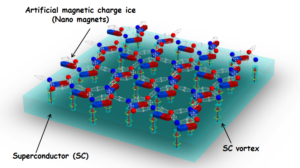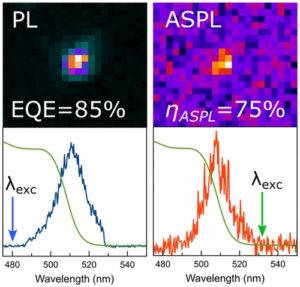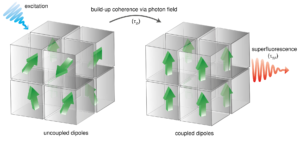Current Research Projects
Confined vortex network of type-II superconductor
In this project, our group study confined superconducting vortex matter, when Abrikosov vortices are confined into a mesoscopic container. When the container is large, the vortices are arranged in a triangular Abrikosov vortex lattice. In contrast, in a mesoscopic container, vortices are arranged in other geometries strongly influenced by the container symmetry.
In order to systematically study the system of confined vortices, we use computer simulations for Abrikosov vortex on mesoscopic superconducting samples. The computational methods we used include: Molecular Dynamic (MD) simulation, Gradient Descent, Eigenvector Following, etc. We developed a network science approach to analyze and represent the complicated energy landscape of these systems. We developed original codes to effectively find local minima (metastable states) and first-order saddle points (transition states) of the energy function, which are then connected to construct a complex network representation of the energy landscape. With the transition barrier on each edge, this is a concise representation encoding the system dynamics.
One of the topics we are particularly interested in is the “magic number” sequence in different containers, corresponding to extraordinary stable states at some specific numbers of vortices. We also investigate the effect of container symmetry and size on these magic number states and differentiate between the so-called angular melting and general melting transitions. Finally, we explore the influence of anisotropic vortex interactions on the structure of mesoscopic vortex matter.
(Xiaoyu Ma, Wenzhao Li, and Lihao Yan)

Optical cooling of semiconductors
Development in cryocooler are critical for academic research and industry. The discoveries of unique phenomena at low temperature, including Bose–Einstein condensation, superconductivity, superfluidity, and the fractional quantum Hall effect, are all based on the ability to reach low temperatures. It is also essential to numerous modern technologies such as visible and infrared photodetectors, which require low temperatures to suppress dark noise and improve device performance. Currently, minimum achievable temperatures for thermoelectric solid-state cryocoolers are around 170 K. So a pressing need exists to develop new solid state cooling technologies suitable for future optoelectronic applications.
The concept of condensed phase optical refrigeration has existed for several decades. In semiconductors, this entails first creating a cold population of free electrons and holes using a laser tuned to the semiconductor band edge. Subsequent phonon coupling results in carrier excitation and leads to emission with energies greater than those of the incident laser. This removes thermal energy from the system and sets the basis for optical cooling. Despite the conceptual simplicity of the process, realizing optical refrigeration requires exacting parameters from the condensed phase medium. This includes near-unity external quantum efficiencies (EQEs) and corresponding up-conversion efficiencies, both aimed at suppressing unwanted background heating.
In this study, we are therefore investigating the potential laser cooling of CsPbBr3 nanocrystals as well as other high EQE nanostructures. The goal is to understand the origin of upconversion in these materials and to eventually demonstrate practical examples of condensed phase optical cooling.
(Shubin Zhang and Sushrut Ghonge in collaboration with the Kuno group)

Superfluorescence from perovskite nanocrystal superlattices
Spontaneous emission is a basic quantum mechanical effect due to the coupling of an excited electronic state with the vacuum state of the electromagnetic field. In an ensemble of identical emitters, cooperative radiation emerges. Called superradiance (SR) by Dicke, who first proposed the phenomenon in 1954, this effect arises from the excitation of an ensemble of individual dipole emitters and results in an emissive, macroscopic quantum state. SR has been observed in a variety of systems, with some of the most recent examples being cold atomic clouds, photosynthetic antenna complexes, quantum dots and nitrogen vacancies in nanodiamonds. A special case of SR is superfluorescence (SF), where the initially prepared state is an incoherent ensemble of emitting dipoles that spontaneously self organizes through their mutual field to generate macroscopic coherence. In an exciting development, SF-like behavior has recently been observed at low temperature (6 K) in a solid state superlattice of CsPbBr3 perovskite nanocrystals (NCs) [Rainò G. et al. Nature 563, 671-675 (2018)]. These superlattices consist of millions of individual NCs self-assembled into ordered arrays with dimensions on the order of microns. Apparent SF distinguishes itself from the normal band edge emission of CsPbBr3 NCs in that it has a 2.7 times faster radiative lifetime. Most importantly, the emission is coherent as seen through first- and second-order correlation measurements.
We have now developed an open quantum model, based on the use of well-known non-Hermitian radiative Hamiltonians, to rationalize SF-like emission from NC superlattices in the weak excitation regime. Our model accounts for interactions between individual NCs and their common light field even for distances larger than the transition wavelength inside the material.
Our aim is to rationalize the recent experimental observations of SF in these materials and to predict some experimental conditions that can allow a stronger, more robust SF.
(Francesco Mattiotti and Sushrut Ghonge, in collaboration with the Kuno group and the Quantum Biology group at UCSC, Brescia, Italy)
